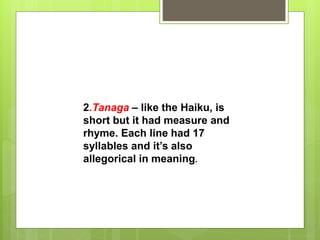Tanaga The Tanaga is a Filipino stanzaic form that was originally written in Tagolog which to my ear is one of the more musical of languages. Haiku a poem of free verse that the Japanese like.

Japanese Period Of Philippine Literature
- 7487353 kathyrabong01 kathyrabong01 24112020.

Tanaga japanese period literature ethnicity. In Philippine literature a tanaga is a poem consisting of four lines with each line equally having between seven and nine. The first difference between haiku and tanka is syllable. HAIKU TANAGA ISHIWARA LIWAYWAY TRIBUNE 1_____.
Japanese Period C 21st Century Period d. Composing renga successive linked verses by several people. A poetic form similar to the Tanaga is.
21st Century Period c. In 1963 Jose Villa Panganiban showcased his collection of 100 tanaga ahead of its Asian counterparts Ö the Japanese haiku and the Malay pantun Ö which are more. The Filipino equivalent of a Japanese haiku is tanaga.
This dissertation investigates how Japanese-language literature by Korean writers both emerged out of and stood in opposition to discourses of national language literature and identity. The use of the vernacular in regional literature is _____ a. The Japanese Period of Philippine Literature 1941-1945.
Tanka in literature a five-line 31-syllable poem that has historically been the basic form of Japanese poetry. FILIPINO POETRY DURING THIS PERIOD The common theme of most poems during the Japanese occupation was nationalism country love life in the barrios faith religion and. However this varies depending on the rhyme schemes.
2Tanaga like the Haiku is short but it had measure and rhyme. The 3rd Republic Period. Here are some examples.
The commonly perpetuated origin for the endonym Tagalog is the term tagá-ilog which means people from along the river the prefix tagá-meaning coming from or native. This period presented new trends in writing using modern technology. Like the Japanese haiku Tanagas traditionally are untitled.
In tanka 5-7-5 is called Kamino-ku upper phrase and. Three types of poems emerged during this period. Tanizakis longest novel Sasameyuki 194348.
Haiku and Tanaga were influenced by what period. The organizations original name was UP Philippines-Japan Friendship Club but was later changed. Japanese Period in Philippine Literature - View presentation slides online.
It was made up of 17 syllables divided into three lines. Haiku is composed of three phrases 5-7-5 and tanka is of five phrases 5-7-5-7-7. Encouraged so that the.
Most are handed down by oral history and contain proverbial forms moral lessons and ethics. FILIPINO POETRY DURING THIS PERIOD The common theme of most poems during the Japanese occupation was nationalism country love and life in the barrios faith religion and. A tanaga consists of four lines with seven syllables each with a rhyme at ending each line.
One of the two newspapers which were not stopped to operate was under surveillance until it was during the. The term tanka is synonymous with the term waka qv. Discouraged because many people do not understand a piece not written in either English or Tagalog b.
The Makioka Sisters evoked with evident nostalgia the Japan of the 1930s when people were preoccupied not with the prosecution of a. Mabuti salam at The. Each line had 17 syllables and its also allegorical.
Scribd is the worlds largest social reading and publishing site. UP Tomo-Kai to embody Japanese literature through creativity in Filipino photography. Around this time the function of literature as a means of social intercourse broadened.

What Was The Theme Of Tons Of Literature During The Japanese Period Quora

Komentar